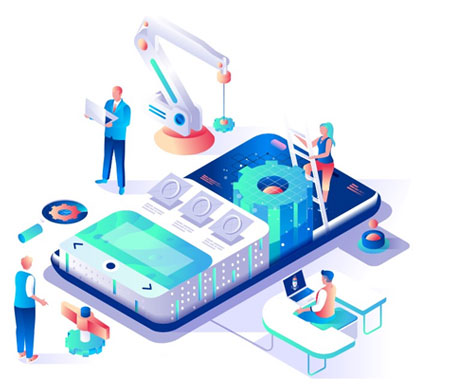The internet is evolving at a rapid pace, and one of the most exciting advancements on the horizon is the concept of the “immersive web.” With the increasing integration of technologies like virtual reality (VR), augmented reality (AR), and 3D experiences, the immersive web is set to revolutionize how we interact with digital content and online platforms.
In this article, we’ll explore how the immersive web is reshaping the digital landscape, improving user experience, and opening up new possibilities for businesses and individuals alike.
What is the Immersive Web?
The immersive web is a new wave of internet experience that transcends the traditional 2D browsing experience. Instead of simply viewing content on a flat screen, the immersive web enables users to interact with digital environments in more natural, engaging ways. This could involve wearing VR headsets to step into entirely virtual worlds, using AR on smartphones to overlay digital elements onto the real world, or exploring 3D spaces that feel much more interactive than typical websites.
How the Immersive Web is Changing User Experience
-
Enhanced Engagement with 3D Environments
One of the most significant features of the immersive web is the ability to experience 3D environments. Websites and online platforms are no longer limited to flat pages and static images. Whether it’s exploring virtual showrooms, visiting online museums, or attending virtual events, the immersive web offers new ways for users to engage with content. This heightened level of interactivity fosters deeper connections with brands, products, and services. -
Real-Time Collaboration and Virtual Interaction
Imagine attending a virtual meeting where you can walk around in a virtual space and interact with colleagues or clients as if you were in the same room. The immersive web makes this possible through virtual reality platforms that allow for real-time collaboration. Users can share experiences, brainstorm, and work together in a way that feels more connected and meaningful than traditional video calls. -
Personalized and Interactive Shopping
E-commerce is one of the areas where the immersive web will have a significant impact. Imagine shopping for clothes in a virtual store where you can try on items digitally, or view a 3D model of a piece of furniture in your living room before purchasing. The immersive web enables personalized shopping experiences, where consumers can interact with products and services in a much more tangible way. This immersive shopping experience has the potential to reduce buyer uncertainty, increase conversion rates, and improve customer satisfaction. -
Immersive Learning and Education
The immersive web has the power to transform education by creating interactive, hands-on learning environments. From virtual field trips to 3D simulations of scientific experiments, students can explore and engage with educational material in ways that were previously impossible. This immersive approach makes learning more enjoyable and effective, offering new ways to experience subjects like history, biology, and geography.
The Impact of Immersive Web on SEO and Digital Marketing
As the immersive web continues to gain traction, it’s crucial for digital marketers and businesses to adapt their strategies to stay ahead of the curve. SEO is evolving alongside this shift, and optimizing for immersive experiences is becoming increasingly important.
-
Immersive Content Creation
Content optimization is no longer just about keywords and on-page SEO. With the rise of the immersive web, brands must focus on creating interactive and immersive content that enhances the user experience. For instance, 3D models, AR-enabled product displays, and virtual tours can improve a website’s engagement metrics, which are important ranking factors for search engines. -
Mobile Optimization for AR and VR
As AR and VR technologies continue to improve, it’s essential for businesses to ensure their websites and content are optimized for mobile devices. Most immersive web experiences, such as AR, are accessed via smartphones, so responsive design and fast load times will be crucial for maintaining good SEO performance. -
Voice Search and Natural Language Processing
The immersive web also plays a role in how we interact with search engines. As users engage with voice-activated technologies and immersive experiences, natural language processing (NLP) and voice search will continue to gain importance. Optimizing content for voice search will help ensure businesses stay visible in the growing world of voice-driven, immersive search experiences.
Challenges and Opportunities in the Immersive Web
While the potential of the immersive web is exciting, there are still several challenges to overcome. The technology needed to support immersive experiences, such as VR headsets and AR glasses, is still in its early stages, and widespread adoption may take time. Additionally, developing immersive content that’s accessible, easy to navigate, and doesn’t overwhelm users is a delicate balance.
However, these challenges present exciting opportunities for businesses and developers. As the immersive web matures, early adopters will have the chance to shape the future of online experiences, building innovative solutions and platforms that captivate users and redefine what’s possible on the internet.
The Future of the Immersive Web
The immersive web is still in its infancy, but its potential to reshape the online experience is undeniable. As technology continues to evolve, users will expect more interactive, engaging, and personalized digital experiences. For businesses and marketers, embracing the immersive web means staying ahead of the competition, improving user engagement, and providing customers with the kind of experience they are increasingly seeking.
Whether it’s through virtual reality, augmented reality, or 3D interactions, the immersive web is revolutionizing how we experience the internet. As we look to the future, it’s clear that the boundaries of the web are expanding, and immersive technologies will continue to redefine how we connect, learn, shop, and collaborate online.
Conclusion
The immersive web is more than just a buzzword – it’s a paradigm shift that’s transforming the digital experience. From creating interactive 3D environments to enabling real-time collaboration and personalized shopping experiences, the immersive web is revolutionizing how we interact with the internet. As this technology develops, businesses that embrace these changes will be at the forefront of the next phase of the digital revolution.
If you’re looking to stay competitive in this ever-evolving landscape, it’s time to explore how the immersive web can elevate your digital strategies and create more engaging experiences for your audience.



